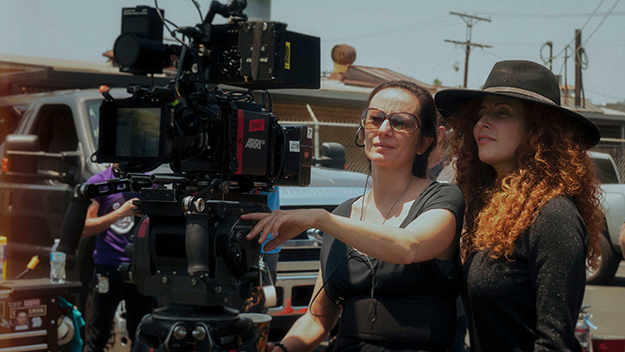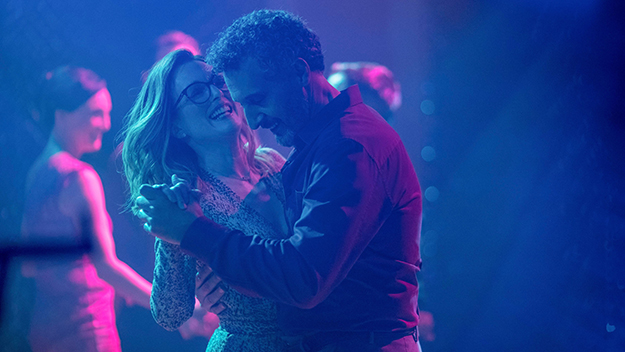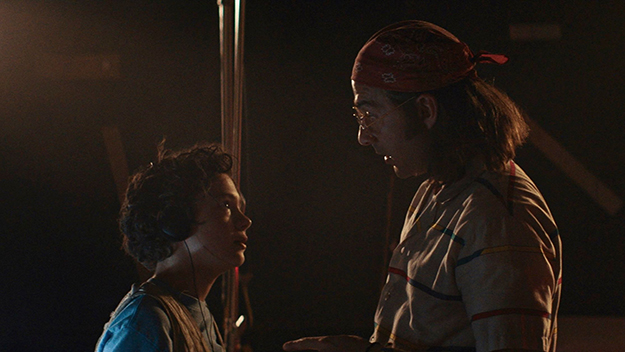Interview: Natasha Braier
This article is part of a series of interviews conducted at the 2019 EnergaCAMERIMAGE International Film Festival in Toruń, Poland.

Cinematographer Natasha Braier and Alma Har’el on the set of Honey Boy (Alma Har’el, 2019)
One of today’s most sought-after cinematographers, Natasha Braier skillfully blends realism and fantasy in Alma Har’el’s Honey Boy (2019), written by and starring Shia LaBeouf as a fictional version of his father, a domineering but devoted recovering alcoholic and Vietnam veteran. Intended as a therapeutic exercise, the film shifts between the childhood and rehab treatment of Otis Lort, a troubled young actor and surrogate for LaBeouf himself alternately embodied by Noah Jupe and Lucas Hedges. Employing a handheld aesthetic and pastel colors, Har’el and Braier craft intimate scenes that inspire empathy for both father and son as they grapple with their demons and attempt to reconstruct themselves in the aftermath of trauma.
At the 2019 EnergaCAMERIMAGE Film Festival, I spoke with Braier about putting the camera to the service of the actors in Honey Boy and the creative freedom she experienced on Nicolas Winding Refn’s The Neon Demon (2016).
Was shooting Honey Boy cathartic for you?
Yes, it was definitely a profound process for everyone on set. As filmmakers, that is to say sensitive people with at least a minimal degree of empathy, we all naturally identified with Shia LaBeouf, whose childhood wounds revived our own.
Did not being able to operate the camera yourself because of American union rules inhibit your spontaneous engagement with LaBeouf’s emotional trajectory?
I operated the camera all my life until I moved to America a few years ago, which was also when I started shooting digital. With film, we would just light by eye. But with digital, we constantly need to go back to the monitor, because we don’t have a direct translation of the lighting through the viewfinder. When I shot The Neon Demon, I thought I would get used to the digital workflow within three weeks and not have to look at the monitor anymore, but this never happened. So even though operating was my favorite part of the job, I find it more convenient now to oversee everything on the monitor and direct someone else to operate through headsets. For Honey Boy, I hired Matías Mesa, a great operator whom I had collaborated with on commercials, and who did a lot of movies with Gus Van Sant and [his cinematographer] Harris Savides [Gerry, Elephant, and Last Days]. Matías is from Argentina like me and we have similar sensibilities, so I knew he would be right.

Gloria Bell (Sebastián Lelio, 2018)
Did you feel stylistically freer and more in control in scenes that didn’t center upon the father-son dynamic in Honey Boy?
I think the notion of freedom is very subjective in cinema, because there are always limitations and obstacles in your way, like in Lars von Trier [and Jørgen Leth]’s The Five Obstructions. Shia’s motel scenes in Honey Boy were a particular challenge that pushed me to get out of my comfort zone and develop new tools and systems, such as using dimmers to change the lighting setup as we were shooting. I had previously experimented with this new technology on Sebastián Lelio’s Gloria Bell [2018], but made full use of it on Honey Boy since we had to let the actors move around freely, and had to be able to shoot in every direction in a small space.
There’s a line that comes off as a metaphor for cinematography’s kinetic qualities in Swimmer, Lynne Ramsay’s short film that you shot for the 2012 Summer Olympics in London: “What I’d like to be is invisible. I’d like to be able to move around without having to explain.” I know that you practiced dance as a child and I was wondering how your work is informed by that experience.
Operating the camera is about getting in synch with the actors and their emotions, and responding with your body to what they do. So it did feel like a dance for the 15 years that I did it. Now, I look for operators who have that sense of dancing as well, and guide them to the best of my ability, but I also choreograph the lights with dimmers. On Honey Boy, I developed the capacity to be more invisible for the actors while also being active all the time by doing adjustments between or during takes. But I don’t know if being invisible was the question for such a stylized film as Swimmer—it was more about being in synchronicity with an athlete and celebrating his physical beauty.

Honey Boy (Alma Har’el, 2019)
In Honey Boy, the question also seems to be the conflation of reality and fiction. This is powerfully conveyed in the first flashback, when young Otis is struck in the face with a cake and flies backward, then the lights turn on and we see the rope tied around his waist and realize he’s shooting a movie—an effect that is repeated in the next scene as he passes by a painted sunset backdrop in the studio’s hallway.
What was important in Honey Boy was to create that space between fiction and documentary but also to convey Otis’s dreamworld and psychological reality. My parents are Freudian shrinks, so I’m super fascinated with any kind of healing modality. When you go through therapy, you’re in contact with your inner child, and there are all these theories in quantum physics that claim time doesn’t exist and if you heal a trauma today, you can take that energy into the past and heal your ancestors. So from a cinematography standpoint, it was interesting to play with the parallel between the adult and the kid and suggest there’s only one space-time [for the character]—that of trauma. Although I was improvising a lot of things on the shoot, my guideline was to blend past and present through camera and lighting, and the edit accentuated those links, like when Otis’s screams in the forest echo with those of his younger self.
It seems like the process of making Honey Boy was the exact opposite of The Neon Demon, which was shot chronologically and where you could manipulate every image to your liking.
With Alma [Har’el], we were concerned with emotion rather than continuity, and tried to be there for the characters in a respectful and empathic way without invading their privacy. With Nicolas [Winding Refn], realism was not a requirement, which meant that I could be a lot freer than usual. Normally, if you go very dark with an image, the director tells you to bring it up so that certain details, like the eyes, are not lost. But Nic always encouraged me to go darker or add more color, and when I asked if I could put some blood on the filter, he was like: “Yeah, bring a whole glass!” Everything was very heightened and there was no fear of failure. So I was like a kid experimenting, and it was extremely liberating to work with somebody who would say: “Look, just try your craziest shit. Jump in the abyss and if we fall, it’s fine. I’d rather you take the risk and go all the way than stay on safe ground.”
Yonca Talu is a filmmaker living in Paris. She grew up in Istanbul and graduated from NYU Tisch.







